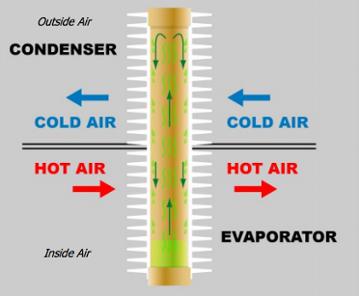What Are the Benefits of Heat Pipe Technology for Enclosure Cooling?

Heat pipe technology is an efficient yet effective approach to enclosure cooling that contains no moving parts except for air circulation fans. This characteristic makes it highly suitable for applications that require a sealed enclosure but have limited power supplies. Noise levels are negligible, so these units can be used in areas where noise would be a problem.
How a Heat Pipe Works
A heat pipe consists of a sealed tube fitted with external aluminum fins to improve heat transfer. The air is evacuated from the pipe which is then filled with a small amount of refrigerant that exhibits suitable characteristics at ambient temperature.
Initially, the refrigerant is in liquid form at the bottom of the tube. As hot air from the enclosure is blown over the bottom section of the tube, this liquid evaporates, and in the process, absorbs heat from the hot air and rises to the top of the tube, thus cooling the air surrounding the bottom of the tube.
The top of the tube is exposed to cooler outside air, and this causes the vapor in the tube to condense back into a liquid. When this happens, the vapor gives off heat that warms the top of the tube. This heat is then transferred to the outside air by the aluminum fins. The condensed liquid flows to the bottom of the tube and the process repeats itself.
Benefits of Heat Pipe Technology
Energy Efficient
The Heat pipe itself uses no power: the energy for its operation is taken from the hot air in the enclosure, which is used to evaporate the refrigerant. In order to improve overall efficiency, a small air circulation fan draws warm air from the electrical enclosure, passes it over the finned tube and returns cooled air back to the enclosure. An external fan blows ambient air over the hot end of the heat pipe to increase the rate of heat removal. Total power requirements are less than 60 watts, yet an air to air heat exchanger operating with a temperature differential of 10 °F can remove 400 watts of heat from an enclosure.
Reliability
Besides the air circulation fans, an air to air heat exchanger is entirely static with no moving parts to fail. With the exception of the small circulation fans, operation is noiseless, which makes an air to air heat exchanger with heat pipe technology an excellent choice for noise sensitive areas. Fans may be AC or DC powered.
No Filters
The design of the external air circuit is such that no air filters are needed. The only maintenance required is to occasionally clean the ambient air fins and the blades of the fan. The lack of filters means that one of the major causes of enclosure cooling maintenance problems is removed, and these units are ideal for operation in areas where frequent access for maintenance is problematic.
Permits Use of Sealed Enclosures
Perhaps the most important benefit of an air to air heat exchanger using heat pipe technology is that it is designed for closed loop cooling. This means that it’s suitable for use in locations where there are high levels of dust and dirt, inclement weather and pollution. The units can be supplied with a powder coated finish for an indoor NEMA Type 12 enclosure or as a sealed outdoor unit with a NEMA Type 4 rating. Models are available with a stainless steel exterior finish and a NEMA Type 4X rating designed for the toughest environmental conditions. If required, the unit can be outfitted for hazardous-area operation.
Thermal Edge air to air heat exchangers are available in several profiles designed to suit the requirements of most electrical and telecom enclosures. It is important to note that, like air circulation fans, these units will maintain the enclosure at a temperature slightly above the ambient air temperature. Before specifying an air to air heat exchanger, use an online Enclosure Temperature Management calculator to verify its capacity. For further information, contact our Sales Team.

